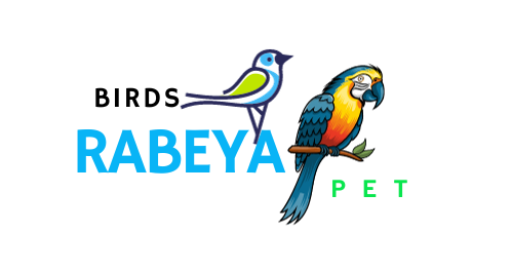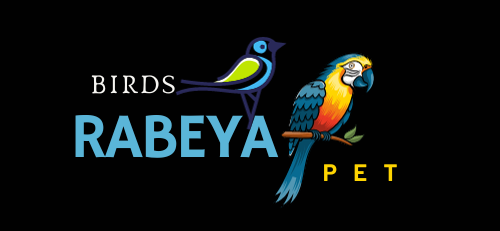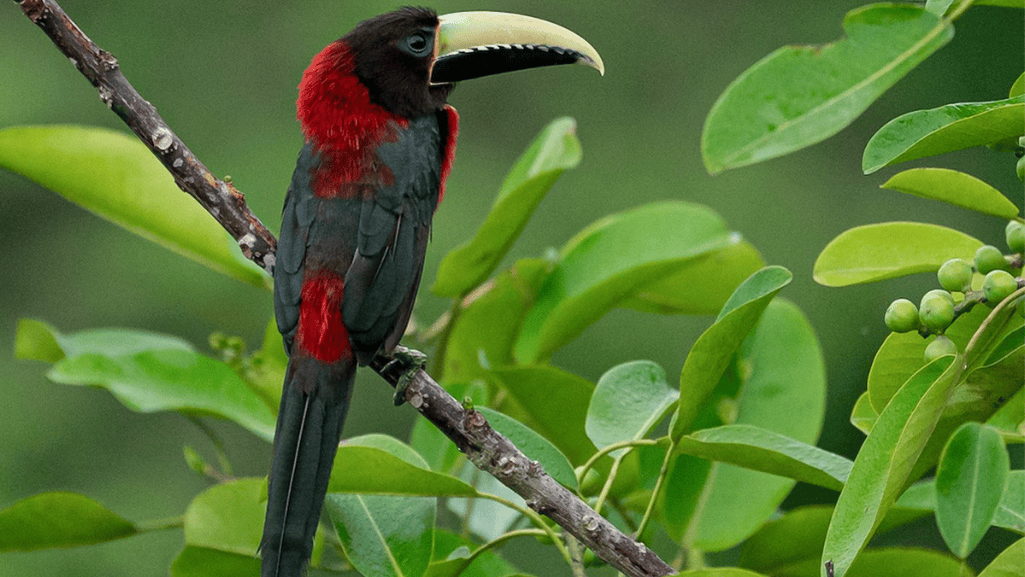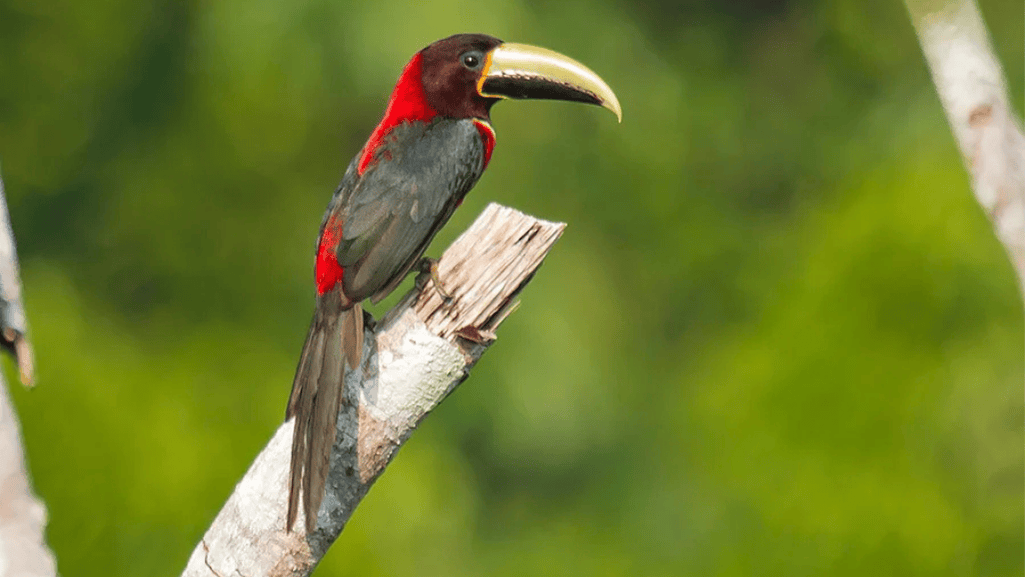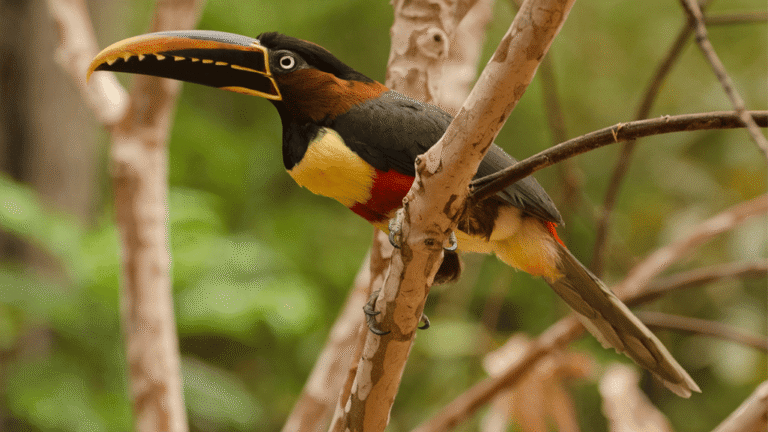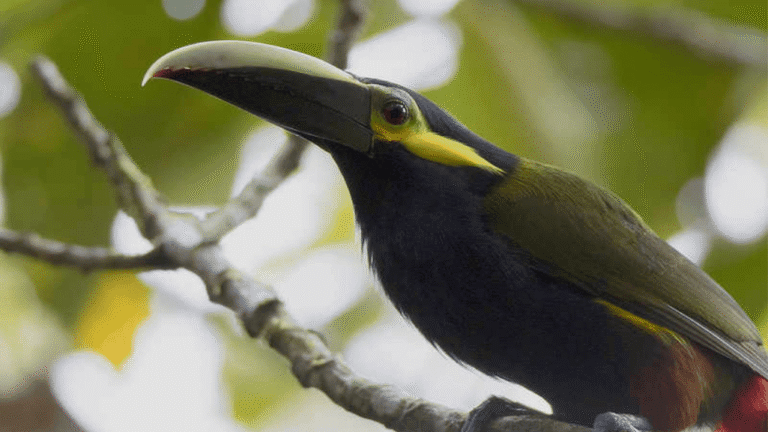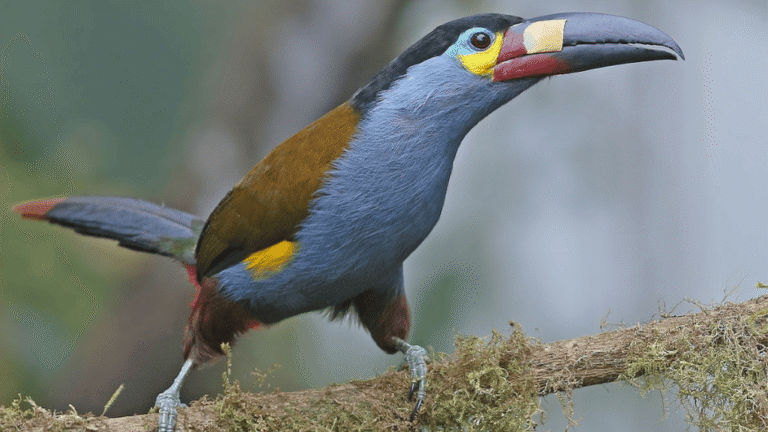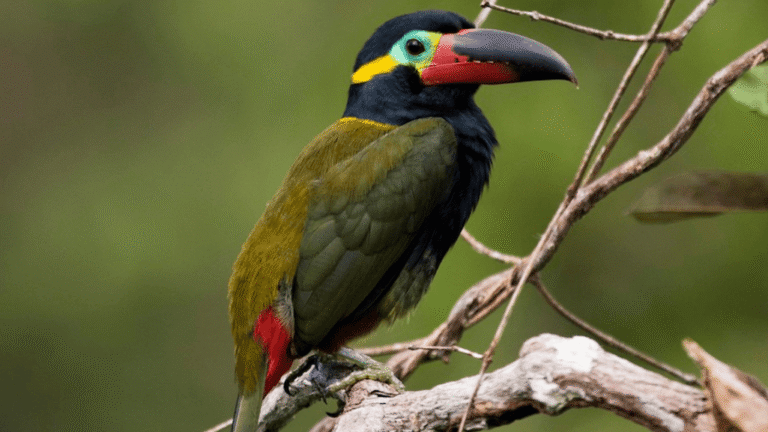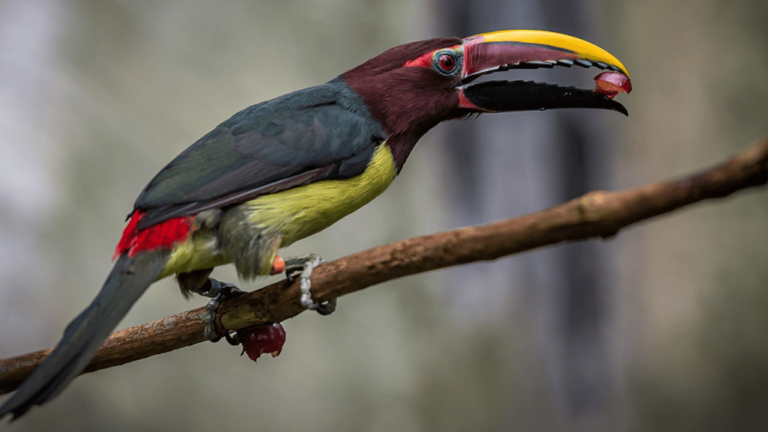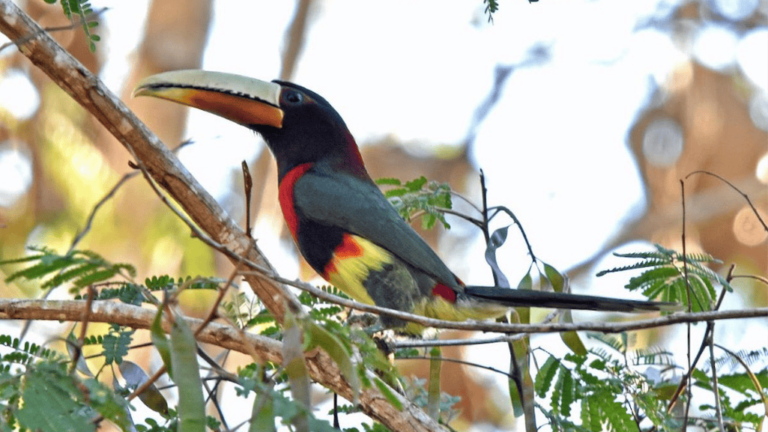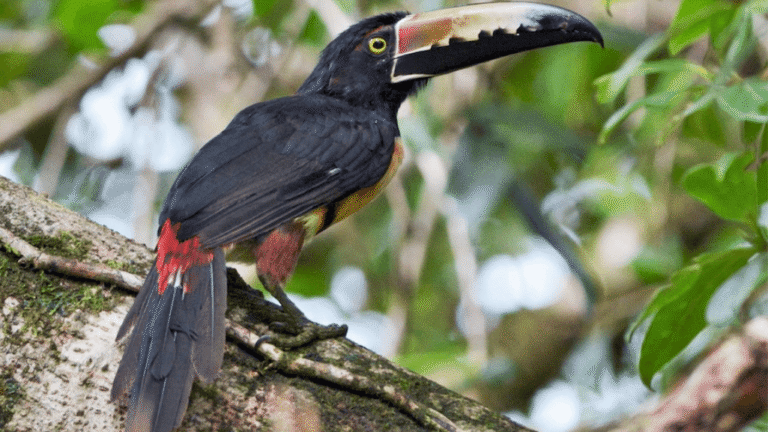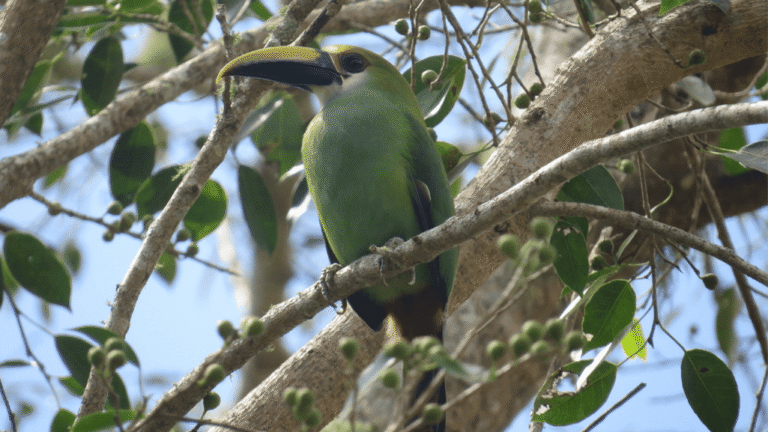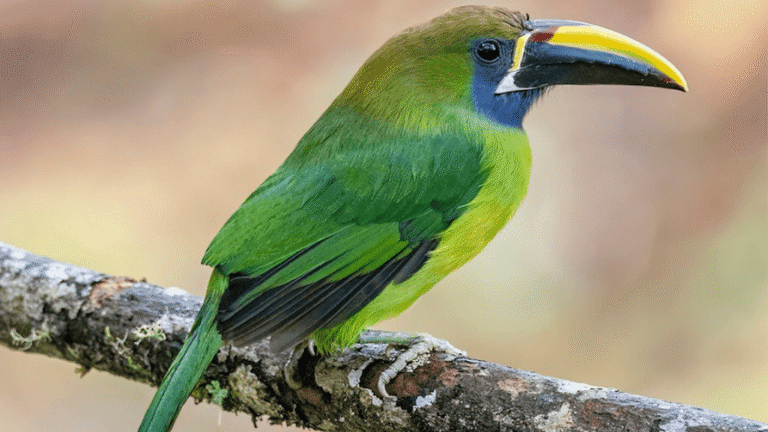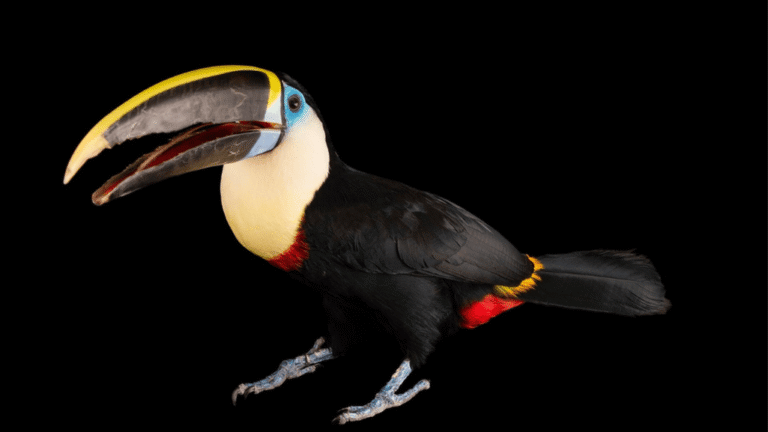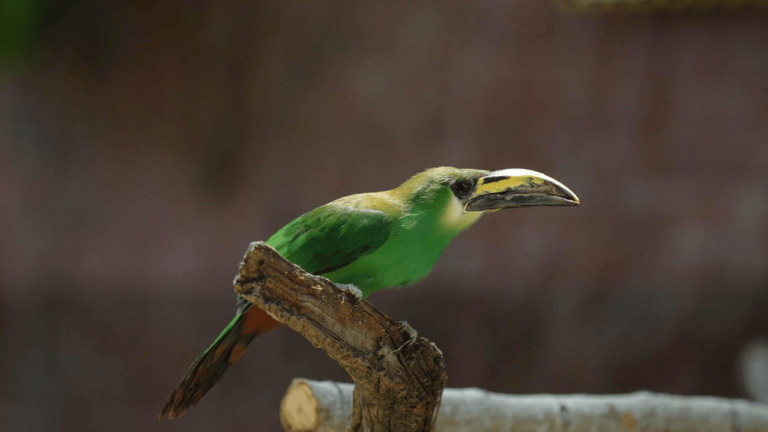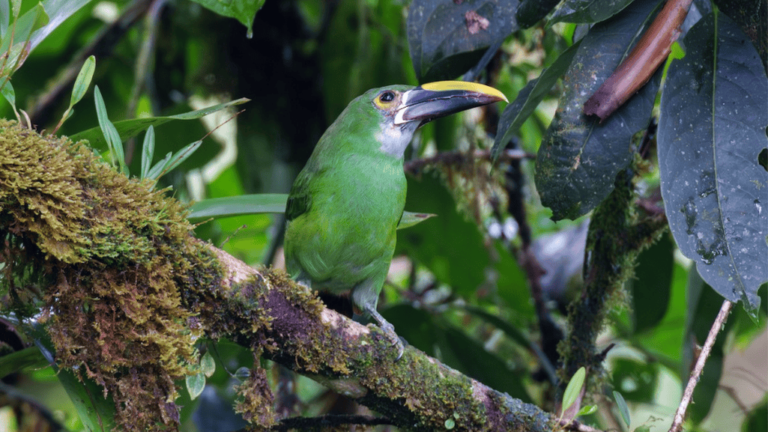The Red necked araicar pteroglossus bitorquatus scientifically known as Pteroglossus bitorquatus, is a vibrant bird found in Bolivia and Brazil. It belongs to the toucan family Ramphastidae. This species is categorized into three subspecies: P. b. sturmii, P. b. reichenowi, and P. b. bitorquatus. The Red-necked aracari is about 36 to 40 cm long and weighs between 112 to 171 g. It has a distinct appearance with a blackish crown and dark brown face, chin, and throat. The nape and breast are red, and the rest of the upperparts are dark green. The red-necked aracari inhabits various forest types, primarily moist tropical terra firme forests, but can also be found in gallery forests in cerrado, dense bamboo, and mature secondary forests. It is an omnivorous bird and primarily feeds on fruits, but also includes insects, eggs, and small vertebrates in its diet. The red-necked aracari is listed as Endangered by the IUCN in some regions due to deforestation in the Amazon basin.
Key Takeaways:
- The Red-necked Aracari, Pteroglossus bitorquatus, is a vibrant bird found in Bolivia and Brazil.
- It is categorized into three subspecies: P. b. sturmii, P. b. reichenowi, and P. b. bitorquatus.
- The red-necked aracari inhabits various forest types, primarily moist tropical terra firme forests, but can also be found in gallery forests in cerrado, dense bamboo, and mature secondary forests.
- It primarily feeds on fruits but also includes insects, eggs, and small vertebrates in its diet.
- The red-necked aracari is listed as Endangered by the IUCN in some regions due to deforestation in the Amazon basin.
Taxonomy and Systematics
The red-necked aracari belongs to the species Pteroglossus bitorquatus and is classified under the domain Eukaryota, kingdom Animalia, phylum Chordata, class Aves, order Piciformes, family Ramphastidae, and genus Pteroglossus.
This fascinating bird species is further categorized into three recognized subspecies:
- P. b. sturmii
- P. b. reichenowi
- P. b. bitorquatus
The taxonomy and systematics of the red-necked aracari have been thoroughly studied and acknowledged by prestigious ornithological committees and authorities, including the International Ornithological Committee (IOC), the Clements taxonomy, and the South American Classification Committee of the American Ornithological Society (SACC).
Subspecies of the Red-necked Aracari
| Subspecies | Scientific Name | Distribution |
|---|---|---|
| P. b. sturmii | Pteroglossus bitorquatus sturmii | North-central Brazil |
| P. b. reichenowi | Pteroglossus bitorquatus reichenowi | Brazil (south of the Amazon River) |
| P. b. bitorquatus | Pteroglossus bitorquatus bitorquatus | Northeastern Brazil |
red necked araicar pteroglossus bitorquatus
The red-necked aracari is a visually stunning bird with unique physical characteristics. This species measures approximately 36 to 40 cm in length and weighs between 112 to 171 g. It features a blackish crown and dark brown face, chin, and throat. Surrounding its piercing eyes are bare blue to greenish-gray skin, adding to its captivating appearance. The distinctive red coloration is found on the bird’s nape and breast, adding a vibrant touch to its overall plumage.
Adult females of the red-necked aracari exhibit slightly different characteristics. They have a browner crown, lighter face, and throat, along with a narrower yellow band above the breast compared to males. Meanwhile, immature red-necked aracaris have duller and browner plumage, with areas that will eventually turn red in adults appearing orange. Variations in plumage patterns and size are observed among different subspecies, such as P. b. reichenowi and P. b. sturmii.
| Physical Characteristics | Adult Males | Adult Females | Immature |
|---|---|---|---|
| Crown | Blackish | Browner | Duller and browner |
| Face, Chin, and Throat | Dark brown | Lighter | Orange (areas that will turn red) |
| Eyes | Bare blue to greenish-gray skin | – | – |
| Nape and Breast | Red | – | – |
The red-necked aracari’s striking appearance makes it a captivating sight in the wild and a remarkable addition to any bird-watching experience.
Distribution and Habitat
The red-necked aracari has a wide distribution, primarily found in Bolivia and Brazil. Within Brazil, it is further categorized into subspecies P. b. sturmii in north-central Brazil, P. b. reichenowi in Brazil south of the Amazon River, and the nominate subspecies P. b. bitorquatus in northeastern Brazil.
These colorful birds inhabit various forest types, adapting to different ecosystems. They can be found in moist tropical terra firme forests, gallery forests in cerrado, dense bamboo, and mature secondary forests.
The red-necked aracari is versatile in terms of habitat elevation, ranging from sea level to approximately 800 meters.
However, the geographic range and population of the red-necked aracari are facing significant threats due to deforestation in the Amazon basin.
| Location | Distribution Range |
|---|---|
| Bolivia | Found sporadically |
| North-central Brazil | Inhabited by P. b. sturmii |
| South of the Amazon River in Brazil | Inhabited by P. b. reichenowi |
| Northeastern Brazil | Inhabited by P. b. bitorquatus |
Behavior
The red-necked aracari exhibits various intriguing behaviors in its natural habitat. Let’s delve into some key aspects of their behavior, including movement, feeding habits, and breeding.
Movement
The red-necked aracari is primarily a sedentary species, with limited local movements. They are typically found foraging from the mid-levels to the canopy of the forest. These birds may forage alone, in pairs, or in small groups, navigating the dense foliage with agility and precision.
Feeding
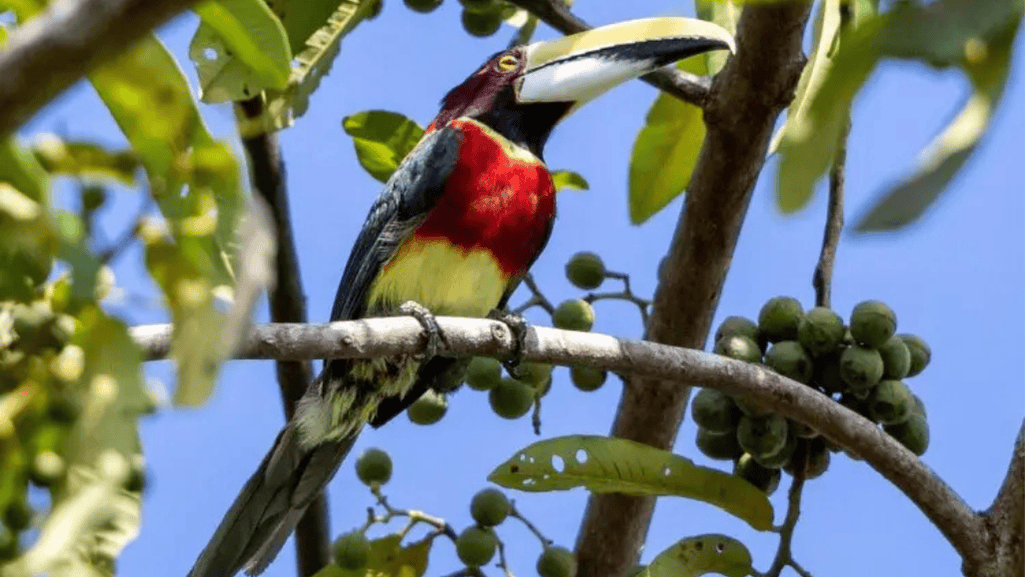 The red-necked aracari has a diverse diet, primarily consisting of fruits. They consume a wide variety of fruits from different trees, playing a crucial role in seed dispersal and forest regeneration. However, their diet is not limited to fruits alone. These aracaris also include insects, eggs, and small vertebrates in their feeding habits, which provide them with essential nutrients for their survival.
The red-necked aracari has a diverse diet, primarily consisting of fruits. They consume a wide variety of fruits from different trees, playing a crucial role in seed dispersal and forest regeneration. However, their diet is not limited to fruits alone. These aracaris also include insects, eggs, and small vertebrates in their feeding habits, which provide them with essential nutrients for their survival.
Breeding
The breeding season for the red-necked aracari typically spans from February to August in most areas, although this may vary slightly depending on the specific location. While their breeding biology is not well known, it is assumed that they nest in tree cavities, similar to other toucans. These aracaris engage in vocalizations, using various calls and notes as a means of communication within their social groups.
The behavior of the red-necked aracari showcases their adaptability to their environment and the critical role they play in maintaining forest ecosystems through their feeding habits and breeding activities.
Conservation Status
The conservation status of the red-necked aracari varies depending on the region and subspecies. According to the International Union for Conservation of Nature (IUCN), the “western” subspecies Pteroglossus bitorquatus sturmii is classified as Least Concern. Although it has a large range, the population of the “western” subspecies is believed to be decreasing.
On the other hand, the “eastern” subspecies, Pteroglossus bitorquatus reichenowi and Pteroglossus bitorquatus bitorquatus, are classified as Endangered. This conservation status is primarily due to habitat loss caused by deforestation in the Amazon basin.
The red-necked aracari faces continued threats from deforestation, particularly in regions like the Chaco and the Atlantic Forest in Brazil. The destruction of their natural habitat is the main driver behind the declining population of these birds.
To understand the conservation status of the red-necked aracari, it is important to assess the threats they face, their population trends, and the habitats they rely on. This knowledge is crucial in developing effective strategies for their protection and ensuring their long-term survival in the wild.
Human Interaction and Significance
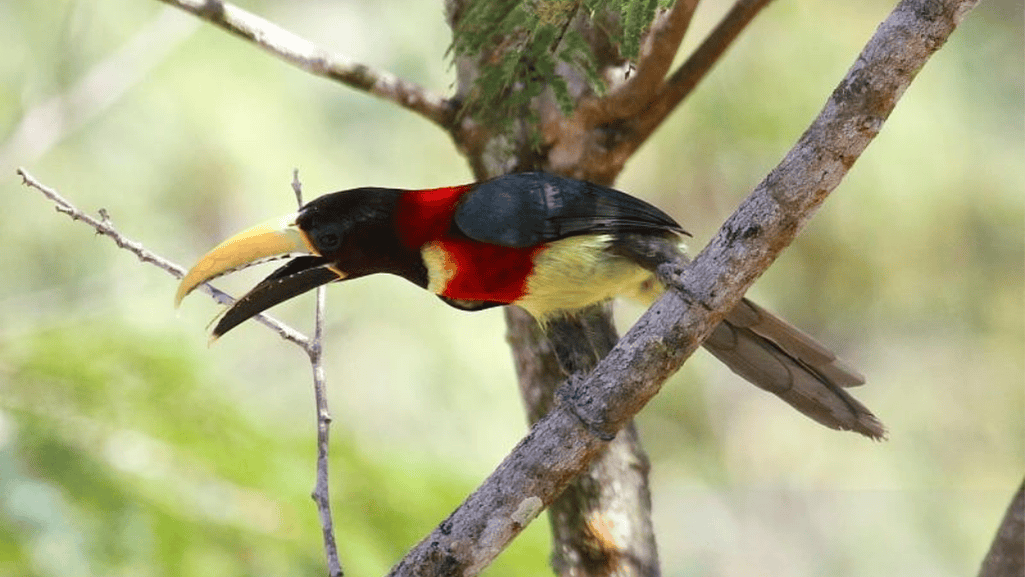 The red-necked aracaris have gained significant attention due to their unique appearance and vibrant plumage, making them highly sought after by birdwatchers and nature enthusiasts. Their striking red neck and colorful feathers make them a fascinating sight in the wild and a popular subject for photography and observation.
The red-necked aracaris have gained significant attention due to their unique appearance and vibrant plumage, making them highly sought after by birdwatchers and nature enthusiasts. Their striking red neck and colorful feathers make them a fascinating sight in the wild and a popular subject for photography and observation.
Moreover, the red-necked aracaris have economic importance in the field of ecotourism. Their presence attracts tourists to conservation areas, contributing to local economies through birdwatching tours, photography workshops, and guided nature excursions. Many birdwatching enthusiasts specifically visit regions where red-necked aracaris can be found, adding to the local tourism industry.
However, it is important to note that while these birds are admired for their beauty, they are not suitable as pets for most people. Red-necked aracaris require specific care and a suitable environment that replicates their natural habitat. Keeping them as pets can be challenging and requires a deep understanding of their needs and behaviors.
While red-necked aracaris are sometimes traded in the pet industry, it is crucial to approach their capture and trade with caution. Unregulated pet trade can have negative impacts on the wild populations of red-necked aracaris, including habitat destruction, stress on captured individuals, and disruption of natural breeding patterns. It is essential to adopt responsible practices when considering the trade and ownership of these birds.
| Red-necked Aracari | Economic Importance |
|---|---|
| Ecotourism | Their vibrant plumage and unique appearance make them attractive to birdwatchers and nature enthusiasts, contributing to ecotourism in areas where they are found. |
| Pet Trade | Although not suitable as pets for most people, red-necked aracaris are sometimes traded in the pet industry. However, this trade should be strictly regulated to avoid negative impacts on wild populations. |
Conclusion
The red-necked aracari, scientifically known as Pteroglossus bitorquatus, is a fascinating bird species found in Bolivia and Brazil. These birds are known for their vibrant plumage, particularly their red neck and unique beak. Inhabiting various forest types, the red-necked aracari has adapted to feed primarily on fruits. However, their populations are facing a significant threat due to deforestation in the Amazon basin.
With their conservation status ranging from Endangered to Least Concern, depending on the subspecies and region, it is crucial to understand the behavior, habitat, and conservation status of the red-necked aracari. This understanding will help promote their conservation efforts and ensure the preservation of their unique ecological role.
To protect the red-necked aracari, it is imperative to address the issue of deforestation in the Amazon basin. Conservation efforts should focus on preserving and restoring their natural habitats. This can be achieved through sustainable land-use practices, reforestation initiatives, and raising awareness about the importance of protecting these beautiful birds and their ecosystems.
Ultimately, the conservation of the red-necked aracari not only safeguards a captivating bird species but also contributes to the preservation of the rich biodiversity found in the forests of Bolivia and Brazil. By taking action to protect the red-necked aracari, we can ensure a future where these birds continue to thrive and enchant us with their vibrant plumage and unique characteristics.
FAQ
What is the scientific name of the red-necked aracari?
The scientific name of the red-necked aracari is Pteroglossus bitorquatus.
What are the characteristics of the red-necked aracari?
The red-necked aracari is a vibrant bird with a blackish crown, dark brown face, chin, and throat. It has a red nape and breast, and the rest of its upperparts are dark green.
Where is the red-necked aracari found?
The red-necked aracari is found in Bolivia and Brazil.
What is the habitat of the red-necked aracari?
The red-necked aracari primarily inhabits moist tropical terra firme forests, but can also be found in other forest types such as gallery forests in cerrado, dense bamboo, and mature secondary forests.
What is the diet of the red-necked aracari?
The red-necked aracari is an omnivorous bird that primarily feeds on fruits. It also includes insects, eggs, and small vertebrates in its diet.
What is the conservation status of the red-necked aracari?
The conservation status of the red-necked aracari varies depending on the subspecies and region. Some subspecies are listed as Endangered due to deforestation in the Amazon basin, while others are classified as Least Concern.
What is the breeding behavior of the red-necked aracari?
The breeding season for the red-necked aracari spans from February to August. They are assumed to nest in tree cavities and use vocalization as an important aspect of their behavior.
What is the significance of the red-necked aracari?
The red-necked aracari has economic importance in ecotourism and is sought after by birdwatchers. However, the capture and trade of these birds for the pet industry can negatively impact wild populations if not regulated properly.
